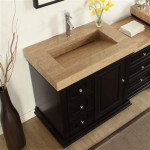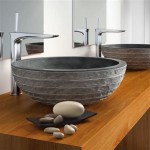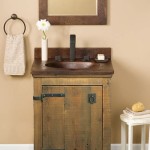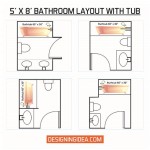Bathroom Vanity Height ADA: Ensuring Accessibility and Comfort
Designing a bathroom that is both visually appealing and functional is a common goal for homeowners. However, when it comes to accessibility, it is crucial to consider the needs of individuals with disabilities. The Americans with Disabilities Act (ADA) sets standards for public and commercial facilities, including bathroom design. One of the key aspects of ADA compliance is the height of bathroom vanities. Proper vanity height ensures individuals with mobility impairments can comfortably access and use the sink.
Understanding ADA Standards for Bathroom Vanity Height
The ADA Standards for Accessible Design specify the minimum and maximum height for bathroom vanities. For standard vanities, the height must be between 29 and 34 inches measured from the finished floor to the top of the vanity. This range accommodates a variety of individuals with different heights and wheelchair users. It's important to note that these are minimum and maximum heights, and designers often choose to go slightly higher or lower depending on the overall bathroom layout and individual needs.
Beyond the overall height, the ADA standard also addresses the depth of the vanity and the clearance underneath. The depth must be at least 21 inches, allowing wheelchair users to approach the vanity and have ample space for their legs. The clearance underneath the vanity should be at least 27 inches, ensuring sufficient space for wheelchair maneuvering.
Benefits of ADA-Compliant Vanity Height
Adhering to ADA standards for bathroom vanity height offers numerous benefits, not just for individuals with disabilities but for everyone using the bathroom:
1. Enhanced Accessibility and Usability:
The primary benefit of an ADA-compliant vanity height is its accessibility. Individuals with mobility limitations, such as those using wheelchairs or walkers, can easily reach the sink, wash their hands, and perform other tasks. This allows for greater independence and self-sufficiency, improving their overall quality of life.
2. Improved Comfort and Ergonomics:
Even for individuals without disabilities, an ADA-compliant vanity height can enhance comfort and ergonomics. The standard height promotes good posture and reduces strain on the back and neck, especially for individuals who spend a significant amount of time in the bathroom.
3. Increased Safety and Reduced Risk of Falls:
Proper vanity height minimizes the risk of falls, particularly for elderly individuals or those with balance issues. This is especially important in bathroom environments, where wet surfaces can increase the risk of slipping.
4. Compliance with Legal Requirements:
In commercial and public facilities, adhering to ADA standards is a legal requirement. By ensuring the vanity height meets the specifications, businesses can avoid potential legal issues and fines. It also demonstrates commitment to accessibility and inclusivity for all individuals.
5. Universal Design Principles:
The ADA standards for bathroom vanity height align with the principles of universal design, which aim to create environments that are accessible and usable for everyone, regardless of their abilities or disabilities. By incorporating these principles into bathroom design, homeowners can ensure that their bathrooms are inclusive and comfortable for all users.
Factors to Consider When Choosing Vanity Height
While the ADA standard outlines the recommended range for vanity height, it's essential to consider other factors when selecting the right height for your bathroom:
1. User Height and Mobility:
The height of the individuals using the bathroom is a crucial factor. If there are tall or short users, adjust the vanity height accordingly. For wheelchair users, it's essential to ensure a comfortable and accessible clearance underneath the vanity.
2. Bathroom Layout and Overall Design:
Consider the overall design of the bathroom, including the size of the space, the location of other fixtures, and the overall aesthetic. The vanity height should complement the surrounding design and create a harmonious flow in the bathroom.
3. Type of Vanity:
The type of vanity also plays a role in determining the appropriate height. For example, pedestal vanities tend to be lower than freestanding vanities. It's important to select a vanity that meets the ADA standards and fits the overall design scheme.
4. Sink Design and Placement:
The design and placement of the sink can influence the effective height of the vanity. Choose a sink that is easy to reach and use, considering the size of the faucet and the position of the handle. For individuals with limited reach, a deeper sink might be more suitable.
5. Additional Features and Accessories:
Consider incorporating additional features and accessories that enhance accessibility, such as grab bars, non-slip flooring, and easy-to-use faucets. These features can improve the functionality and safety of the bathroom for individuals with disabilities.
By carefully considering these factors and adhering to ADA standards for bathroom vanity height, homeowners can create a safe, accessible, and comfortable bathroom for everyone.

Ada Compliant Bathroom Sinks And Restroom Accessories Laforce Llc

Ada Compliant Bathroom Sinks And Restroom Accessories Laforce Llc

Ada Compliant School Stainless Steel Sinks

Ada Bathroom Planning Guide Mavi New York

Ada Compliance Bathroom And Vanity Federal Brace

Ada Compliant Bathroom Sinks And Restroom Accessories Laforce Llc

Designing Your Ada Compliant Restroom Crossfields Interiors Architecture

Ada Compliance Bathroom And Vanity Federal Brace
Ada Restroom

The Top Wheelchair Accessible Bathroom Vanity







